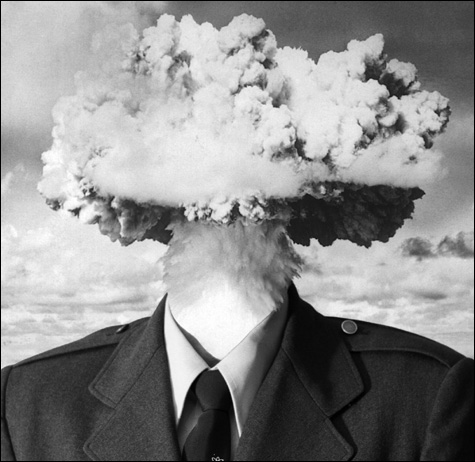
Bruce Conner, Bombhead |
“Atomic Afterimage” at BU Art Gallery, 855 Comm Avenue, Boston | September 5–November 2 | 617.353.3329 “Red Lines, Death Vows, Foreclosures, Risk Structures” at MIT’s Compton Gallery, Building 10-150, 77 Mass Ave, Cambridge | September 9-December 21 | 617.253.4415 “Dorothy Imagire And Ben Sloat” at Simmons College’s Trustman Gallery, 300 the Fenway [fourth floor], Boston | September 2–October 3 | 617.521.2268 |
Tick, tick, tick . . . something ominous is upon us. Is the end near, or is this just déjà vu? Even as Russia gets aggressive with neighboring Georgia and the American sub-prime mortgage meltdown continues to threaten our neighborhoods and the global economy, timely new exhibitions look at the lust for power and risky business.Opening at the Boston University Art Gallery on September 5, “ATOMIC AFTERIMAGE: COLD WAR IMAGERY IN CONTEMPORARY ART” brings together work by 10 artists — among them Bruce Conner, Joy Garnett, and Richard Misrach — who reinterpret images from the era of above-ground nuclear testing (1945–1962). Garnett bases apocalyptic paintings on declassified photographs of nuclear explosions. Conner, in one fine example, uses his skillful way with collage to merge a figure wearing a military jacket with an iconic image of mushroom clouds from the first underwater atomic bomb test at Bikini Atoll, reanimating (and giving a psychological dimension) to an image of power and destruction that might not seem as safely far in the past as it used to.
The complex — and currently unraveling — relationship between finance and buildings is the subject of “RED LINES, DEATH VOWS, FORECLOSURES, RISK STRUCTURES: ARCHITECTURES OF FINANCE FROM THE DEPRESSION TO THE SUB-PRIME MELTDOWN,” an exhibit by Damon Rich and the Center for Urban Pedagogy (CUP) that opens at MIT’s Compton Gallery on September 9. Rich, who founded the CUP in 1997, is trained as an architect, and in this project he investigates the history and mechanics of financing the places we call home. During his year-long residence at MIT’s Center for Advanced Visual Studies (in 2005, well before sketchy financing schemes and lending practices across the country reached the headlines), he undertook a study of the fundamentals of real-estate markets, working with MIT students and volunteers to interview folks like the Comptroller of the Currency in Washington, and hanging out with mortgage brokers in bars in Boston. In “Red Lines,” he uses video, sculpture, graphics, and photography to reveal the inner workings and nitty-gritty details of how our neighborhoods have been created and manipulated and are on the verge of being destroyed.
How we manage to get along at all in our global neighborhood, what with our various ethnic groups, religious beliefs, cultural memories, and the like, is one of the big questions posed by a new series of exhibits, “In Between: The Cultural DMZ,” at Simmons College’s Trustman Gallery. The series kicks off on September 2 with “DOROTHY IMAGIRE AND BEN SLOAT,” which pairs Sloat’s photographs of a series of “lady-shaped” shampoo bottles produced by Avon in the 1970s with Imagire’s “Mixed-Race Kimonos” exploring Asian-American female stereotypes.